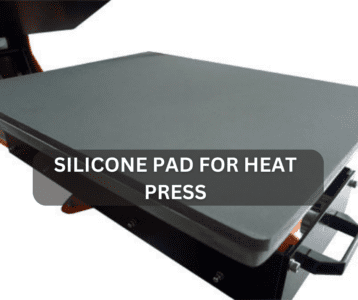Heat press machines are becoming increasingly popular for a variety of craft projects. Whether you are creating custom t-shirts or fabric bags, heat pressing is an effective way to customize your items with images or text. In this article, I will explain how to use silicone pad for heat press and the benefits of silicon pads.
One of the most important components of a successful heat-pressing project is the use of a silicone pad. With it, your project may have a better image and better quality results. It is an effective way to transfer designs onto a wide range of materials.
Whether you’re trying to customize apparel, mugs, or other items, using a heat press and silicone pad can help you achieve professional-looking results. If you’re new to using a silicone pad for heat pressing, this article will explain all the steps and tips you need to know for success.
Let’s get started.
How To Use Silicone Pad For Heat Press
Are you looking for an easy way to press your fabrics with a heat press? If so, then silicone pads are the answer. Silicone pads are relatively inexpensive and easy to use, making them an ideal choice for people who want to quickly and efficiently press their fabrics.
Here are the steps to using a silicone pad for heat press:
Step 1: Setting Up The Machine
Setting Up The Machine is essential. To ensure a successful project, make sure the machine is level and secure before beginning. Begin by checking the feet of the machine to make sure they’re adjusted correctly so that it sits firmly on the work surface. For extra stability, place something heavy near or on all four corners of the heat press.
Once you’ve ensured that all 4 feet are in contact with the tabletop and won’t slip around during use, you can begin setting up your heat press machine for use. Be sure to properly install all cables and wires according to manufacturer instructions before plugging them in.
Step 2: Cut Pad to Size
It is the stage where you make sure that your pad fits perfectly into whatever design you are creating. To do this, measure out the space you need to fill with your pad and then cut it in half or thirds if necessary. Make sure each piece is slightly larger than its designated area, making it easier to fit around tight corners or curves.
When cutting the silicone pad, use sharp scissors or a craft knife; otherwise, the edges may be too frayed after being cut and won’t lay flush against your design. For curved surfaces, draw a line on the back of the material first so you can easily see where exactly you should cut it.
Step 3: Place Pad on Press Plate
This step is especially important when working with materials that require more pressure to create a satisfactory imprint. When placing the pad on the press plate, users should ensure that it is centered and lined up correctly.
It’s also important to ensure that there are no air bubbles or wrinkles in the material being pressed, as these can cause uneven heating and poor prints.
Step 4: Set Pressure and Temperature
Pressure helps ensure an effective transfer of the design onto the fabric, while the temperature will vary depending on the material used. Ensuring these settings are properly adjusted will help users achieve professional-looking results.
To begin setting pressure and temperature, adjust your heat press machine to its highest setting and place a thermometer inside. Close your machine and wait until it reaches its preset temperature before opening it again to check the thermometer reading.
Step 5: Place Transfer or Garment on Pad
Step 5 of using a silicone pad heat press is to place the transfer or garment on the pad. To ensure that all areas of the fabric are pressed evenly, take care when positioning the item. Begin by aligning one edge with either the left or right side of the pad before centering it in place.
Once perfectly centered over the pad, apply pressure to smooth out any wrinkles or bumps in your fabric. Using a spatula-like tool to gently rub down and flatten your item on top of the silicone pad may be helpful. It will help ensure you get an even print from corner to corner.
Step 6: Activate Heat Press
Before you power up your machine, you should double-check that both the top and bottom platen are properly locked in place and that there aren’t any obstructions blocking their movement. Once everything is secure, plug in the heat press and turn it on.
Using the temperature knob or digital controls, set your desired temperature based on your particular product’s instructions. When ready, press down firmly on both platen handles until they lock into place. It will ensure a tight seal between them so that even pressure can be applied across all areas of your garment when pressed.
Benefits of Silicone Pad
Silicone pads are one of the most versatile tools used in heat pressing. They provide an important cushioning layer between the heat press and the printed material, protecting it from damage and ensuring a uniform application of heat. It also has many other benefits worth exploring.
-
- They are easy to use and clean, making them ideal for any situation where frequent cleaning is necessary.
- It provides excellent protection for the heat press machine and whatever item you’re pressing.
- The non-stick properties of silicone keep materials from sticking to the pad itself, reducing wear and tear over time.
- It has excellent thermal insulation qualities that help maintain even temperatures throughout the printing process.
- It makes it possible to print on delicate fabrics without fear of burning them or having them stick to the pad’s surface.
- Protecting your materials from direct contact with the platen reduces friction and helps prevent scorching or smudging.
Conclusion
The conclusion of this article on how to use silicone pad for heat press is simple: it’s an inexpensive and effective tool to ensure that you get the results you want. You can easily ensure your finished product looks perfect with just a few items and some basic knowledge.
When using a silicone pad with a heat press, be sure to take into account the thickness of the material being pressed. It’s also important to make sure that the pressure is correctly adjusted for each type of material being used.
It will help maintain even heat distribution and prevent any damage or imprints from appearing on the fabric or paper being pressed. Ultimately, using a silicone pad with your heat press can be an excellent way to achieve consistent results time after time.

I’m Henry Collins and living my happy life. I’m a professional businessman and I own and run 6 Heat Pressing Services stores where I provide my clients with custom Designs on hats, mugs, T-Shirts and a lot more using Heat Press Machine. Been using a heat press for the last 4 years and people love my work. As I’ve got enough information on Heat Press I decided to make a blog on it and share my knowledge with the world. I hope, the world will appreciate it.

